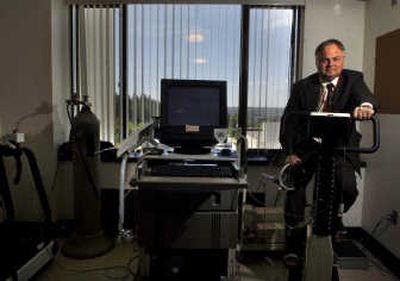Test can ID cancer surgery candidates

It’s a grim dilemma for lung cancer patients and their doctors: Surgery is often the only option for survival, but many sufferers are too sick for surgery.
Or are they?
That’s the question at the heart of new research by a Spokane lung specialist, who found that a simple exercise test often used on elite athletes can predict good candidates for life-saving cancer surgery.
Dr. Gregory M. Loewen, a pulmonologist with Spokane Respiratory Consultants, led a five-year study involving nearly 350 of the sickest lung cancer patients at nine hospitals across the country. His researchers discovered that by using an oxygen uptake or “V02” exercise test, they could identify patients who would tolerate surgery – even though standard tests said they wouldn’t.
“It is not rare to find patients who may be denied surgery because of poor lung function tests even though their cancer would be curable with an operation,” said Loewen, 50, the former director of Pulmonary Medicine at the Roswell Park Cancer Institute in Buffalo, N.Y.
The results of the study were published in the July issue of the Journal of Thoracic Oncology, the journal for the International Association for the Study of Lung Cancer.
The bottom line message for lung cancer patients turned down for surgery?
“Don’t take ‘No’ for an answer the first time,” said Loewen.
Loewen and others are quick to note that that message doesn’t apply to the vast majority of people diagnosed with the most deadly form of cancer. About 85 percent of lung cancers are not operable because they’re detected too late and they’ve already spread to other organs, such as the brain.
But in the minority of patients whose disease is detected early enough, about half are turned down for surgery because they fail traditional pulmonary function tests, Loewen said.
Those patients should insist that their doctors administer a test more commonly used to measure the peak performance of elite runners and cyclists, he said.
A tiny exam room on the eighth floor of Sacred Heart Medical Center’s main building houses one of the region’s V02 testing labs. Despite the cryptic name, the testing device is fairly simple: a stationary bicycle hooked to a plastic cylinder and linked to a computer.
Patients pedal the bike while wearing a mask, which measures the physical exertion and chemical components of every breath, in combination with the efforts of the heart, Loewen said. When patients reach their peak of exertion, the point when they can’t work any harder, their V02 level is logged.
“That measure is the amount of oxygen the heart can pump per minute divided by their body weight,” Loewen said.
In elite athletes, for instance, a peak V02 of 65 isn’t unusual.
In a healthy person digging a ditch, a V02 of 30 might be expected, while someone holding a normal conversation might post a V02 of 20 to 22, Loewen explained.
In lung cancer patients, however, a peak V02 might not rise above 10.
Loewen’s research found that people with V02 levels less than 15 or 16 were not good candidates for surgery, and that those with levels of 10 or less definitely were too sick for surgery.
But people with V02 levels above 15 could contemplate surgery, the research showed, even if they haven’t done well on more common pulmonary function exams.
“We give them full approval,” said Loewen, whose research discovered that 58 people who previously had been turned down for surgery could go ahead with the procedure.
It’s a distinction that can mean the difference between life and death. Patients in Loewen’s study who had surgery had a median survival time of nearly 31 months, more than twice that of patients who didn’t have surgery.
Loewen’s group wasn’t the first to propose that V02 testing might be helpful for cancer patients. Swiss researchers had previously explored the question, Loewen said. And other cancer doctors were familiar with the theory, noted Dr. Douglas E. Wood, a professor and chief of general thoracic surgery at the University of Washington in Seattle.
Loewen’s work, conducted between 1993 and 1998, was the first multi-institution examination of the question, said Wood, who hasn’t met Loewen but saw his article in the July journal. “It actually solidifies research that has been done with patients in single settings,” he said.
The findings will have practical value for the more than 3,900 people who are diagnosed with lung cancer in Washington state each year – and the more than 3,100 who die as a result of the disease.
Each year in Spokane, some 292 people are diagnosed with lung cancer, and some 244 die, according to most recent figures from the state Department of Health. Nationally, about 213,000 new cases of lung cancer are expected in 2007.
Dr. Kyle Hogarth, an assistant professor of medicine at the University of Chicago, called Loewen’s research “extremely significant work” that could lead to longer survival for some lung cancer patients.
Queried separately, Hogarth and Wood said that lung cancer patients could take a couple of lessons from the new research. First, the doctors agreed, patients who’ve been turned down for surgery because of poor lung function should ask for a V02 test.
And, they added, patients should insist on an opinion from a specialist, preferably an experienced thoracic surgeon who’s not afraid to take on risky clients.
“That’s something I feel strongly about,” Wood said. “Patients with lung cancer need to have the opportunity to have surgery, even if they’re old, even if they’re high risk.”